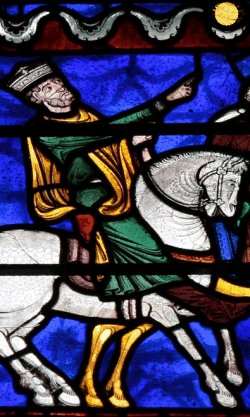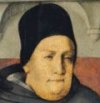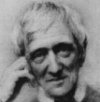The story of the Magi
Matthew 2,1-23
In the study of New Testament historicity the episode of the Magi constitutes a chapter of its own. It may truly be considered a
test case. We can to some extent measure by it the validity of any
conception of New Testament literary forms.
We will first rapidly
survey the present position of research on the episode, paying
special attention to the kind of historicity attributed to it. We will
then try to give a new exposition of the midrash theory. Finally we
will discuss the place of this midrash in Christian "kerygma",
both past and present.
|
First Observation
Scholars raise many questions about the historicity of the story of the Magi.
During the closing decades of the nineteenth century, the new
rationalistic approach to scripture did not fail to affect also the
infancy narratives of Matthew and Luke. Scholars such as
Holzmann, Hilgenfeld, Dieterich, Usener and Wellhausen subjected the story of the Magi to a rigorous historical examination.
Their verdict proved to be a negative one. Impressed by the parallelism of birth stories in the Greco-Roman world, by the contradictions with Luke, by the unlikely details and apologetic tendencies
in this narrative of the Magi, they pronounced against its historicity. Dieterich sums up with the statement that the episode of the
Magi developed as a legend from two sources: belief in birth-announcing stars and the expectation of persons who according to
prophecy were to bring gold and incense to the Messiah. To these
German scholars then the narrative of the Magi, grown as a legend
without any factual foundation in history, deserved no historical
credit.
In reaction to this position many a Christian scholar asserted
his acceptance of the factual historicity of the narrative. These
gallant defenders count among their ranks renowned commentators
and writers of the early twentieth century: Knabenbauer, Lagrange, Plummer, Allen, Benning, Klostermann, Baldi and Fonck.
But also more recent authors break a lance for the historical
reliability of the facts narrated, among whom we reckon: Houdous,
Simon-Dorado, Fuller, Richards, Schmid, Gaechter and Bonnard.
The arguments adduced in favour of this position vary much in
range and quality. An appeal is made to the interest Babylonian
astrologers took in Canaan, to an expectation of a saviour even in
the non-Jewish world. To the historically attested visit of Parthian
Magi to Nero and to Flavius Josephus' testimony regarding
Herod's cruelty. More than one author explains the star as a
natural phenomenon, such as Halley's comet or a specially bright
conjunction of stars. The Magi are said to have realised the significance of the astronomical phenomenon because of Balaam's
prophecy regarding the star that was to rise from Jacob, or
because of Daniel's prophecy regarding the time of the Messiah's
coming, or again on account of a prophetic utterance attributed to
Zarathustra.
However much these authors may differ in explaining
various details, they would certainly subscribe to Allen's careful
formulation of the episode's historicity:
'We need not press every detail of the narrative. Descriptive
detail may have crept in (in some small measure) from the Old
Testament or from analogous literary or folklore stories . . . The
main outline of the story, however (the expectation of a Jewish
redeemer, the interest of Eastern Magi, their coming to the
West), is noteworthy for its historical probability.'
The rationalistic rejection of the episode has, on the other hand,
also been met by a more tolerant approach. Many students of St.
Matthew's Gospel have come to admit that the visit of the Magi
and the accompanying events are possibly unhistorical. At the
same time, however, these scholars contend that the narrative has a
truly historical message to bring.
This paradoxical contention rests
on the assumption that in the second chapter of Matthew the
literary form of historical midrash was employed, in which form a
kernel of teaching from the Old Testament is clothed in narrative
explanations. In various shades this theory is found with Zahn,
Loisy, McNeile, Levertoff-Goudge, Lohmeyer-Schmauch, Daube,
Bloch and Bourke.
It is my conviction that this theory, if correctly
understood, combines the advantages of a solid critical foundation
and true insight in New Testament historicity.
|
Second Observation
The story of the Magi as it stands cannot be fully historical.
Let us begin our analysis with a critical look at the facts narrated.
From a historical point of view they appear to be highly problematic. The story abounds with interior contradictions.
- Would an
unbelieving, Pharisee-detesting Herod convoke the Sanhedrin?
- Would he do so asking for a biblical quotation which any scribe could have given him?
- What further need of the star once the
prophecy had been recalled and the Magi directed to Bethlehem?
- Is it likely that the distrustful Herod would allow the Magi to go
their way without at least a spy to watch their movements?
- Moreover, if the coming of the Magi upset the whole of Jerusalem, if
their adoration at Bethlehem and the murder of the infants were
known to tradition, why does neither Flavius Josephus, nor Jesus
himself, nor John, Mark, Peter, Paul or any other apostle, nor
even Luke in his infancy narrative, allude to this fact?
- What was the evangelist's source of information on such hidden
matters as Herod's secret council with the Magi and the angel's
apparitions to them and to Joseph?
 |
The Magi seeing the star
Canterbury Cathedral
1632 |
Instead of relying on historical
witness, the author would rather seem to draw his material from
contemporary legend:
- the birth of great persons was thought to be
heralded by the apparition of stars;
- the Messiah was expected to
be born under such a star;
- certain stars were believed to guide
travellers "moving along with them";
- the journey of 'Magi' to
Nero may have set the example of how Isaiah 60: 1-7 could be fulfilled;
- the miraculous escape from enemies at birth is a frequent
theme in birth stories, such as in those of Moses, Abraham, Romulus, Cyrus, Paris and Oedipus.
Add to this the undeniable
apologetic tendencies of providing a plausible explanation for
Jesus' dwelling in Nazareth and of exposing the inexcusable blindness of the Jewish leaders! All these considerations point to but
one conclusion: the historicity of the events described is highly
problematic.
If the actual adoration by the Magi, the actual
slaughter of the infants and the actual flight to Egypt were to be
taken as the norm of historicity, the story might certainly have to
be qualified as un-historical.
But is this the case? Does the author of this chapter want to
teach the actual, objective, historical occurrence of these events,
or is there another historical truth that he has in mind? Only a
careful analysis of the text itself can decide this question. |
Third Observation
The story of the Magi is theological reflection, a midrash, that reflects on whcih place the new Messiah belongs to.
Reading the second chapter of St Matthew's Gospel attentively, one is struck by the prominence of what we might call the theme of place, the theme of locality.
- The 23 verses have 31 direct and indirect indications of place: Bethlehem is mentioned five times, Jerusalem twice, Egypt four times, Nazareth and Galilee each once, the land of Israel twice, the East three times; more general indications, such as 'their land,' 'all townships around it,' 'there', 'Ramah,' and so on, another 11 times.
- What is even more surprising, all the indications of place refer to definite localities, known by name, except for the generality 'the East.'
- All the four explicit quotations from the Old Testament concern places: 'And you, O Bethlehem in the land of Judah' (v. 6), 'Out of Egypt I have called my son' (v. 15), 'a voice was heard in Ramah' (v. 18) and 'He shall be called a Nazarene' (v. 23).
- Similarly, God's miraculous interventions have no other purpose than to direct his servants to the right place: the star leads the Magi to Jerusalem (vv.l-2) and later to the house 'where the child was' (v. 9). They are warned in a dream not to return to Jerusalem (v. 12). An angel instructs Joseph to go to Egypt with the child (v. 13). Again an angel appears to make him return to Israel (v. 20). A third time he is warned in a dream to settle in Galilee (v. 23).
The whole passage is
dominated by the theme of place.
It will further be noticed that locality is of interest to the author
in as far as that locality belongs to the newly-born Messiah.
- It is
Christ whom the Magi seek at Jerusalem and whom they find at Bethlehem.
- It is Christ who has to flee to Egypt, who is taken back
to Israel and finally directed to Nazareth.
- The Magi's question:
'Where is the newborn king of the Jews?' (v. 2), repeated by
Herod in its more precise form: 'Where should the Christ be
born?' (v. 5), truly characterises the central theme in the mind of
the author, the birthplace of the Messiah.
Other Gospel passages underline the weight of this problem in
early Christian apologetics.
- Nathaniel objects: 'What good can
come out of Nazareth?' (John 1,46);
- the people doubt: 'Could the
Christ come out of Galilee?' (John 7,41);
- the Pharisees remark
scornfully: 'No prophet is raised from Galilee!' (John 7,52).
All
this presupposes that Jesus' provenance from Nazareth was
handled as an argument against his Messiahship. Luke's elaborate story of how Joseph and Mary travelled to Bethlehem so that
the Child was born there and not in Nazareth (Luke 2,1-39) serves
the same purpose. The question where the Christ should be born
and whether Jesus had complied with prophecy in this matter was
not of mere academic interest. To all appearances it was a moot
point in Jewish polemics against Christians, a bone of contention
that demanded a clear Christian reply.
Keeping all this in mind, we may reconstruct the origin of
chapter two in St Matthew's Gospel in the following manner.
In
the course of discussions with Jewish Rabbis, the author had
singled out a number of Old Testament passages which could be
said to refer to the birthplace of the Messiah:
- Micah 5,2. - 'You, O Bethlehem Ephrathah . . . from you shall
come forth for me one who is to be ruler in Israel.' The Aramaic
Targum renders the text as follows: 'The Messiah will come out
of you to take up dominion over Israel'; the same inference is
made in Pirqe Eliezer. Even if these texts be post-Christian,
they witness to the Messianic interpretation given to Micah 5,2
in Jewish tradition.
- Numbers 24,17. - 'A star shall come forth out of Jacob and a
sceptre shall rise out of Israel.' The Targum Onkelos,theTargum Jerusalem 1, and various passages in the Talmud refer this text
to the birth of the Messiah. In their interpretations the Messiah
himself is the star. Other Jewish literature expresses the
expectation that the Messiah will be announced by a star. The
phrase 'out of Israel' may have been taken in a local sense.
- Isaiah 60,1-7. - 'Arise, shine; for your light has come, and the
glory of the Lord has risen upon you ! ' These verses are addressed
to Jerusalem. A few lines earlier we read: 'I will come to you as
redeemer' (Isaiah 59,20). The rising of a light would naturally be
taken as an allusion to a birth. Further on it is stated that the
Lord Himself will be the sun, the moon and the light (Isaiah 60,19-20). It is not difficult to imagine that this text was explained
as prophesying the birth of the Messiah at Jerusalem, where all
the foreign kings will come to adore him.
- Hosea 11,1. - 'Out of Egypt I have called my son.' In combination
with Messianic passages such as: 'You are my son, today I have
begotten you' (Psalm 2,7), this verse was taken to refer to the
Messiah. It would seem that the prophet thus attributes to the
Christ an Egyptian origin.
- Jeremiah 31,15. - 'A voice is heard in Ramah . . . Rachel is weeping for her children.' The phrase 'a voice is heard' denotes both
a cry of anguish or a shout for joy. The expression also occurs
with the specific connotation of the woman who cries out when
giving birth to a child. Jeremiah 4:31: 'I heard a cry as of a woman in
travail, anguish as of one bringing forth her first child.' And in
Jeremiah 30,5ff we read: 'We have heard a cry of panic, of terror and
no peace . . . Why do I see every man with his hands on his loins,
as a woman in labour?' Jewish literature speaks of the special
birth pangs that will accompany the birth of the Messiah. Since
the second half of Jeremiah 31,15 describes 'Rachel' as 'weeping over
her children', the voice heard in Ramah could be explained in
Rabbinical exegesis as the birth of the Messiah at Ramah,
accompanied by the expected throes.
- Isaiah 9,l-2. - ' . . . The land of Zebulun and the land of Naphtali, towards the sea, across the Jordon, Galilee of the Gentiles -
the people who sat in darkness have seen a great light and for
those who sat in the region and shadow of death light has
dawned.' That the appearance of this light should be connected
with the birth of the Messiah follows from the rest of the oracle
which reads (vv.6 f.): 'For to us a child is born, to us a son is
given; the government will be upon his shoulder, etc.' In Christ-
ian apologetics this passage could with some right be handled as
prophesying that Galilee be the Messiah 's birthplace !
- Isaiah 11,1. - 'There shall come forth a shoot from the stump
of Jesse and a branch (neser) shall grow out of its roots.' The
fact that Christ was called a branch, a 'neser', would fascinate
any Rabbi. Quite in harmony with prevailing rabbinical verbal
magic, Christians would see a connection between Christ being
a Nosri (inhabitant of Nazareth) and the cryptic being a neser attributed to the Messiah by the prophet.
The early Christian apologete who composed the chapter may
have listed all those texts with the localities connected with the
Messiah's birth: Bethlehem (Micah 5,2), Israel (Numbers 24,17), Jerusalem (Isaiah 60,1-7), Egypt (Hosea 11,1), Ramah (Jeremiah 31,15),
Galilee (Isaiah 9,1-2) and Nazareth (Isaiah 11,1).
He may have seen it to
be his main task to illustrate that it was in harmony with prophecy
that Christ was born in Bethlehem, yet took up his dwelling in Nazareth. With this in mind he reconstructed the history of Jesus'
childhood in the form of a historical midrash which would effectively link up all these biblical quotations. To compose the story he
may have drawn from existing traditions, historical or legendary,
about the star and the adoration of the Magi, about Herod's
persecution and the flight to Egypt. It may also be that he inferred
these events from the Old Testament texts themselves.
Whatever
his sources, he skilfully elaborated a story which would do justice
to the theological implications of Jesus being the saviour of the
whole world and also to the prophetic expectations of his origins.
|
Fourth Observation
The midrash of the Magi revolves round the messianic prophecy of Isaiah chapter 60.
All through the narrative the author seems to build round chapter 60 in Isaiah. He recounts how the light shining over Jerusalem (vv. 1-2) is fulfilled in the star. Delegates come from distant nations
to adore the newborn Messiah and, as foretold (vv. 3-7), they flock
to Jerusalem. The Jewish Sanhedrin voices a slight correction:
'No, it is not in Jerusalem, but in Bethlehem that the Messiah is to
be born.'
- The Magi go and bring their gold, myrrh and incense as
prophesied (v.6), disappearing all of a sudden. This last detail is
also hinted at by Isaiah when he says immediately after mention-
ing the foreigners who came to worship: 'Who are these that fly
like a cloud . . .?'! (v.8).
- The allusion to oppression (vv. 10, 14,15)
gives the occasion to introduce Herod's persecution which causes
Christ's flight to Egypt (fulfilling Hosea 11,1) and the cry in Ramah
(fulfilling Jeremiah 31,15).
- The phrase in verse 18: 'Violence shall no
more be heard in your land', provides the author with the chance
to have Joseph recalled from Egypt since 'those who sought the
child's life are dead' (Matthew 2,20).
- When verses 19 and 20 then
continue to speak of the Lord being Israel's light, the tactical withdrawal to Galilee can be explained in the sense of Isaiah 9,1-2. This
text, which prophesied that the light of the Messiah would shine
on Galilee may have had its original place here (at Matthew 2,22).
- The
reference to 'neser' in verse 21 ('the branch of my planting')
would naturally introduce the settlement at Nazareth, linking it
with the 'neser' prophecy of Isaiah 11,1.
Chapter 60 in Isaiah formed
the prophetical background against which the infancy story is
painted.
 |
| Byzantine mosaic, ca 600 AD |
It is my conviction that a midrashic commentary of this kind may
already have been in existence when it was taken up and inserted
into the Gospel by its composer. The theme of Christ as 'the persecuted Son of Man', the theme of the Pharisees' wilful rejection
of Christ, the theme of salvation for the whole world, the theme of
Christ as second Moses, perhaps even the theme of Christ's
relation to political power: all such themes could well be integrated
with some modification into Matthew's Gospel.
It is the final
redactor of the Gospel of Matthew who may also have introduced his own
stylistic touch, such as the quotation formulas employed all
through the Gospel, and the schematic arrangement of the pericopes.
In brief, St Matthew or whoever composed the Gospel,
found this midrash on Christ's birth and, modifying it, inserted it
into his Gospel.
|
Fifth Observation
The midrash of the Magi should be understood as a commentary on Jesus' mission as the Messiah announced by the prophets.
The literary form of midrash, or as in the case at hand of haggadah [= narrative midrash],
is at times viewed with suspicion. To some critics this refined form
of exegesis has become almost synonymous with indulging in
legends.
Against such prejudice it should be stressed that midrash
is a beautiful form of biblical commentary which does not want to
create legends, but which often explains biblical passages by
integrating them into a story.
Examples may illustrate this point.
A Rabbi finds four scripture passages on the creation of human beings:
'after God's image' (Genesis 1,26); 'God repented of having made
man' (Genesis 6,6); 'what is man that Thou art mindful of him' (Psalm
8,5); and 'even to your old age I am He . . . I have made and I
will bear' (Isaiah 64,4). In order to combine them in a harmonious
explanation, he recounts how God discussed with his angels how
he was to create human beings, and in the form of question and answer
these biblical quotations are introduced.
Did the Rabbi want to
convey that this conversation had really taken place? Of course
not: the setting was his own. But he did want to teach some basic
historical truth about God's determination to create human beings in spite
of their future sins.
In a similar way many scriptural passages are interwoven in
such historical haggadahs: concerning Joseph, Israel in the desert,
Moses, Saul, Abraham, Joshua and so on. As an interesting parallel may serve the haggadah about the Hebrew midwives in Egypt:
here we find as many as nine biblical quotations referring to
midwifery twined into the story. In all these cases the historical
events narrated serve to bring out the fuller meaning of the biblical
texts and their mutual relationship.
The midrash on Christ's birthplace (Matthew 2) should be interpreted in the same light. Employing this literary form early Christian teachers did not want to teach the arrival of the Magi, the
murder of the innocent children and the flight to Egypt as historical
facts. But they did want to show that Christ's withdrawal from Bethlehem to Nazareth is in harmony with Old Testament prophecy. They also wanted to teach the theological implications of
his birth. Far from being a mere legend, this midrash made its
hearers appreciate the reality of Christ's birth far more profoundly
than by a meagre statement of the few physical facts known. In
this way haggadah can become a genuine literary form that
teaches historical truths, even if it does so - paradoxically - by an
imagined reconstruction of events.
|
Sixth Observation
The evangelist who inserted the midrash of the Magi into the Gospel of Matthew understood the nature of this kind of literary form.
How did St Matthew himself, or whoever inserted this midrash
into the Gospel, understand the passage? Did he, perhaps, take
all the events described as historical facts? Many authors say 'yes'
to this question. They say 'yes' because they think that the historicity of the rest of the Gospel is put by the author on one line with
the historicity of the Magi narrative.
- Levertoff-Goudge remarks:
'Indeed it is possible that the story of the Magi is, at any rate in
part, a Christian midrash rather than authentic history, though the
compiler of the Gospel may not have recognised its true character'.
- Plummer states: 'There can be no doubt that the evangelist regards this narrative, like that of the Virgin birth, as historical. He
has it on what he believes to be good authority, and he would have
his readers accept it as completely as he does himself'.
- Allen puts
it this way: 'In view of the matter-of-fact character of the editor of
the Gospel, it is almost certain that he believed that he was transmitting matters of actual fact'.
- Similarly Lagrange, who defends
the historicity of the passage in the light of the entire Gospel.
All such argumentation rests on the assumption that the evangelist could have employed only one and the same kind of literary
form throughout his Gospel. Old Testament parallels would sufflce
to put us on our guard: the historical books from Genesis to Esdras
blend anecdotes, tribal traditions, legends, historical events,
hero sagas and accurate reports into the one history of salvation.
But, restricting ourselves to Matthew, does his Gospel really
present that homogeneous historical treatise that it is thought to
be?
- Does Matthew not place Christ's sermons and actions in theologically significant settings, such as 'on the mountain' (cf. Matthew 4,8; 5,1; 8,1; 14,23; 15,29; 17,1; 24,3; 28,1-6) or 'in the desert' (cf.
Matthew 3,1; 4,1; 11,7; 15,33)? At times he surely draws from precise
traditions, but does he not on other occasions create such a setting
to recall the first covenant on Mount Sinai and Israel's former
journey through the desert?
- Does Matthew not insert the midrash of Jesus' temptations (Matthew 4,1-11)?
- Would any modern scholar put the
historicity of the resurrection event on the same line as the historicity of the midrash in which Peter is said to catch a fish with a
shekel in its mouth?
- Does Christ's temptation in the desert not
exhibit midrashic characteristics similar to those of the Magi
narrative?
Throughout his Gospel Matthew reveals great familiarity with Jewish and Rabbinical ways of thinking. He is addressing a Jewish audience. How could he fail to understand the literay form of midrash?
Matthew certainly wanted to teach the historical fact
of Jesus' redemptive activity: in this aspect all parts of his Gospel
are historical; but he taught this truth through a variety of
literary forms. The precise historical value of details cannot be
deduced from the general character of the Gospel, but only from
the literary form of the passage in question.
In my opinion it is only when St Matthew's Gospel entered
Hellenistic Christianity that it began to be understood as literally
historical in all its details. The Greeks did not know the force and
value of midrash. They would naturally come to regard the events
narrated as genuine facts. The Magi are now considered historical
figures, whose origin, whose number, whose names, whose past
histories become the subject of popular curiosity as well as of
theological discussion.
|
Pastoral Reflection
The story of the Magi important teaching on Jesus' birth and mission that can be easily appreciated by people today - without us having to stress the historicity of its details.
Supposing that the
episode of the Magi were eventually to be universally accepted by
scholars as a historical midrash, would it not create doubt and
uncertainty among the ordinary faithful who so far held the story
to be historical in all its details? What attitude should the modern
scholar take when exposing or explaining this scriptural passage to
the faithful?
 |
| Rembrandt, 1632 |
First and foremost, the object of kerygma, the object of Matthew's teaching regarding Christ's birth, remains the same,
whether he teaches through haggadah or by means of an accurate
narration of facts. It is not the actual coming of the Magi, the
actual murder of the innocents, the actual flight to Egypt that are
at stake, but the mystery of the incarnation itself. It is, therefore,
irrelevant to faith whether these details are believed to be historical or not. What matters is faith in Christ, the Son of God who
became man to save the whole world, not faith in the Magi.
Secondly, the very disagreement among scholars warns us not to
impose our views on others, whatever it may be. Even if we
personally are convinced of the midrash theory, we have no right
to proclaim it as if our interpretation were the only valid one. When referring to this narrative in pastoral situations, we may
prudently abstain from discussing modern explanations when
these would cause confusion. Instead of upsetting our faithful by
interpretations that will only be half understood, we should stress
the positive teaching contained in the chapter. Rather then
emphasize the actual historicity of the details, we should bring out
the theological themes dear to the evangelist. In the further future
the midrashic character of the story may cause as little difficulty
to our lay people as the current explanation of Genesis, chapter
one!
Father McKenzie's example is much to the point here: a Christmas crib may represent the Holy Family in a way that is far removed from the historical situation. Yet no one would regard such
artistic treatment as a distortion of the historical reality. A prudent
pastor when explaining such a crib to children will stress its positive sides, passing over in silence whatever may not agree with
Palestinian conditions. Pointing out historical shortcomings to
children would unnecessarily upset them, unless they be grown
up, and sufficiently mature to see the distinction between the
unhistorical form and the historical contents !
|
|
 Credits Credits
Much of the text in our course Interpreting Scripture Correctly is based on publications by John Wijngaards.
This particular text on the Magi appeared first as 'THE MAGI AND
CHRISTIAN KERYGMA' in the Indian Journal of Theology, Vol, XVI, Nos. 1 & 2,
Jan. - June 1967)
|




 Credits
Credits







